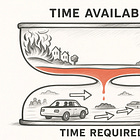Evacuation Timing, an LA AAR, Seeing Strategy & More
Profiles in Preparedness #45
Welcome back to The CP Journal, where we break down what it takes to get left of bang.
Preparing for an uncertain future is the deliberate act of tipping the odds of success in your favor—whether facing a disruption or pursuing an opportunity—by:
Reducing the time required for you or your organization to take effective action, and/or
Increasing the time available before that action becomes necessary or the window for action closes.
Readiness is achieved when the time available exceeds the time required.
While much of the “time available” before disasters, disruptions, and crises is dictated by the threat or hazard itself, the “time required” to evacuate a community is something we can directly influence.
There are opportunities to proactively reduce the amount of time needed to detect unfolding incidents, mobilize responders, develop an understanding of the situation, provide effective alerts and warnings to the public, and begin the evacuation itself.
Through enhancing situational awareness, developing actionable plans, improving coordination, delivering engaging training, and countless other acts to build the capability, agencies can systematically reduce the amount of time required and shift the balance of time available/time needed to a point where there is a large enough window to complete the process.
But the concept is not limited to public safety or evacuations. The same principle applies to businesses, nonprofits, and governments navigating volatile markets, technologies, or policies.
It starts with recognizing the readiness delta that exists for the disruptions and opportunities you care about. The readiness delta is the measurable gap between the time available and the time required to act and is what allows you to objectively evaluate whether you are ready to operate within the external conditions that surround your organization.
When the delta is positive, your organization is left of bang. Your foresight and capability allow you to outpace the rate of external change. When the delta is negative, the environment is likely to change more rapidly than the organization’s ability to adapt. Failure becomes increasingly likely.
Readiness isn’t about prediction—it’s about positioning. It’s the result of two continuous pursuits:
Building foresight: expanding awareness and anticipation of external changes.
Building operational ability: enhancing your capacity to act when those changes occur.
It doesn’t guarantee success, but that level of readiness certainly tips the odds of success in your favor.
Inside The CP Journal
Here is an article that was added to the site this week.
This article looks at the constant race between the time available and the time required to move people safely out of harm’s way when an incident demands it.
The article is part of a growing list of resources designed to improve how agencies prepare for incidents that require evacuating the community.
This Week‘s Reads
Here are a few standout reads from this week with insights, ideas, and perspectives that caught my attention.
Article | Learned helplessness is hurting the security industry. Whether intentional or not, there are things people say in the security industry that create a sense of victimhood, making our mission harder. This article breaks down why sayings like “It’s not if, it’s when,” and “Attackers only need to be right once, defenders need to be right all the time,” and “people are the weakest link,” might sound clever, but are actually self-defeating narratives that are holding us back.
Article | Perceptual Complexity: Seeing Strategy from Different Mountains. Your understanding of your organization’s strategy changes with your perspective. While language can give the illusion of shared understanding (which is rarely there), it creates a fragmentation in your organization once people leave the room. For a strategy to be effective, it requires a blend of divergence and convergence, making this article a must-read for leaders asking why their strategy never becomes truly operationalized.
After-Action Review | Alert Notification Systems and Evacuation Policies for the Eaton and Palisades Fires. I’ll be doing a deeper dive on this AAR in the coming weeks once I share a few takeaways with our evacuation planning clients. Still, when looking at two of the fires that ignited in LA this past January, the review did not identify a “single point of failure” in the County’s efforts to warn and evacuate residents in the face of multiple simultaneous fires in areas across the County. Instead, it found that a series of weaknesses, including “outdated policies, inconsistent practices and communications vulnerabilities,” hampered the effectiveness of LA County’s response.
Article | You can’t call people “luddites” for having taste. I enjoyed this look at and defense of creators maintaining high standards in their use of tech tools, despite their critiques of the ever-present AI-hype. Creators have been early adopters of tech for decades, but the people creating work that lasts and endures are those who have a “practiced eye for what works, a deep disdain for cheap facsimiles, and a commitment to craft and detail.” As Adam Singer weaves into this narrative, amateurs obsess over tools, pros over mastery.
Enjoyed This Issue? Pass It On and Go Deeper.
If this newsletter sparked ideas or challenged your thinking, share it with your network, a colleague, or on social media. Sharing is how we expand the community of professionals committed to getting and staying left of bang.
And if you want to go further, become a paying subscriber for exclusive access to:
The Tactical Analysis Course & behavioral analysis practice exercises from the book Left of Bang.
A growing list of playbooks and resource guides that are being developed alongside our client work to prepare for an uncertain future.
Exclusive “left of bang leadership” articles, sent out twice a month.
And if you’re thinking about how to strengthen your organization’s preparedness, that’s what we do. Whether it’s strategy development, assessments, planning, speaking events, or exercises, we help teams build the skills and strategies to stay ahead of the next challenge.


